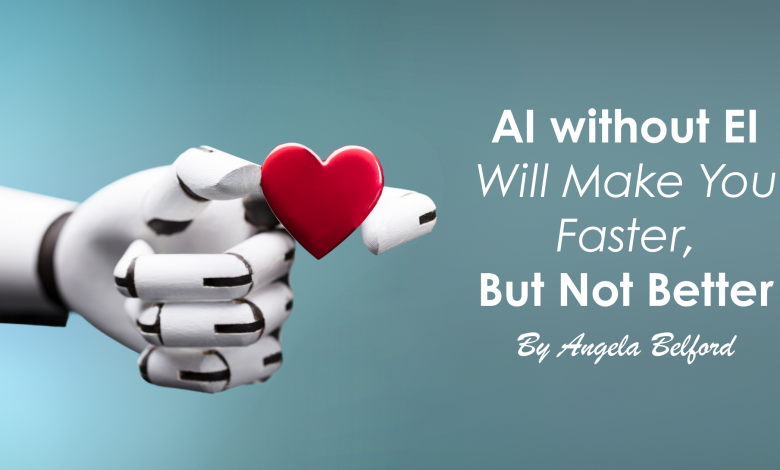
AI can help you move faster. No question.
It can automate your meetings, summarize your strategy, brainstorm your next big idea, and even help you map out the steps to execute it. But if you’re not careful, it can also strip the heart out of your leadership.
Because speed isn’t the same as wisdom.
Automation isn’t the same as empathy.
And information isn’t the same as connection.
You can use AI to get more done. But that doesn’t mean you’re leading better.
The best leaders – the ones people trust, follow, and remember – don’t rely on AI alone. They bring something AI can’t replicate.
They bring Human Intelligence (HI) and Emotional Intelligence (EI).
Without HI and EI, AI becomes a shortcut with no soul. You’ll get faster, but not better. More efficient, but less human. And in the long run, that breaks trust, culture, and teams.
The Suitcase and the Fear That Fueled It
Years ago, I traveled to Chennai, India for a service project. I showed up with a giant suitcase packed with everything I thought I might possibly need. Extra shoes, power adapters, snacks for every mood, and a 64-ounce jar of peanut butter.
I told myself I was being responsible. Prepared. Strategic.
But the truth is, I packed all of that out of fear.
I was afraid of not being ready. Afraid of being uncomfortable. Afraid that I wouldn’t be enough on my own.
That suitcase wasn’t about what I needed. It was about what I didn’t believe I had.
And I see leaders doing the same thing today.
We overpack our leadership roles with dashboards, tools, meetings, metrics, AI platforms, and productivity hacks because, somewhere deep down, we’re afraid that being human means being weak – or worse, being replaceable.
But here’s what I learned from that trip: I didn’t need the peanut butter. I didn’t need the extra stuff. I needed to show up with presence, flexibility, and openness. I needed to trust myself.
Leadership is the same. We don’t need to carry everything. We need to carry what matters.
And what matters now more than ever is human intelligence and emotional intelligence.
What AI Can’t Do For You
AI is a tool. A powerful one. But it has limits.
It can analyze performance, but it can’t sense when someone on your team is quietly shutting down.
It can write an email, but it can’t have a conversation.
It can summarize a meeting, but it can’t pick up on what wasn’t said – the tension in the room, the hesitance, the silence.
Those moments require a human. They require leadership that isn’t just informed, but aware.
HI – Human Intelligence – gives us the ability to connect dots that machines can’t see. To weigh trade-offs that involve people, not just numbers. To sense nuance, to read context, to bring wisdom into decision-making.
EI – Emotional Intelligence – helps us build trust, navigate conflict, and lead with presence. It helps us read a room, own our triggers, show empathy when someone’s struggling, and know when a high-performing team member is burning out behind the scenes.
You can’t automate that. You have to show up for it.
Making Space to Lead
Once AI takes the repetitive, the reportable, and the robotic off your plate, you get to show up differently.
You stop racing. You start thinking. You become more aware – not just of your tasks, but of your tone.
Suddenly, you have the margin to say, “How are they really doing?” instead of “Did they hit their numbers?”
You have the clarity to ask, “Is this decision aligned with our values?” instead of “Will this scale?”
You have the presence to respond to the emotional undercurrents instead of pretending they don’t exist.
That space is where the best leadership happens.
Leading Faster Doesn’t Mean Leading Well
Let’s be clear. I’m not anti-AI. In fact, I’ve been using AI tools in my business for years – long before ChatGPT made it mainstream.
I use it to brainstorm, to outline, to draft, to summarize. It’s a fantastic tool. But I never let it replace my judgment, my insight, or my voice.
If you’re not careful, you’ll start letting AI speed you up in ways that remove the human heartbeat from your leadership.
You’ll make decisions faster, but without considering their emotional impact.
You’ll communicate more often, but less effectively.
You’ll get more done, but no one will feel more seen.
That’s not leadership. That’s output.
The Real Risk
If we let AI run the show without bringing our humanity, here’s what happens:
Your team starts to feel like metrics.
Decisions lose nuance.
Messages sound polished but feel cold.
People disengage.
You can’t spreadsheet your way into trust. You can’t automate a coaching conversation. You can’t outsource emotional safety.
These are things only humans can do.
AI can get us to the table. But it can’t carry the heart of the meeting. That’s on us.
What Leadership Really Requires
Leadership in the age of AI isn’t about knowing every tool.
It’s about knowing what to hold onto, and what to finally let go of.
Let go of the need to prove your worth by doing it all.
Let go of the belief that productivity is the same as value.
Let go of the idea that faster always means better.
Hold onto your wisdom.
Hold onto your presence.
Hold onto your people.
AI can make your life easier. It can clear your calendar, draft your emails, and polish your plans. But it will never know your team the way you do.
It will never notice the sigh in someone’s voice or the fear behind their silence.
It will never replace your ability to lead with clarity, courage, and care.
That part is still yours.
Final Thought
You don’t need to carry everything.
You don’t need to lead like a machine.
You don’t need to be perfect to be powerful.
You just need to show up. Fully. Honestly. Human.
That’s what leadership has always needed.
And that’s what it needs now more than ever.




